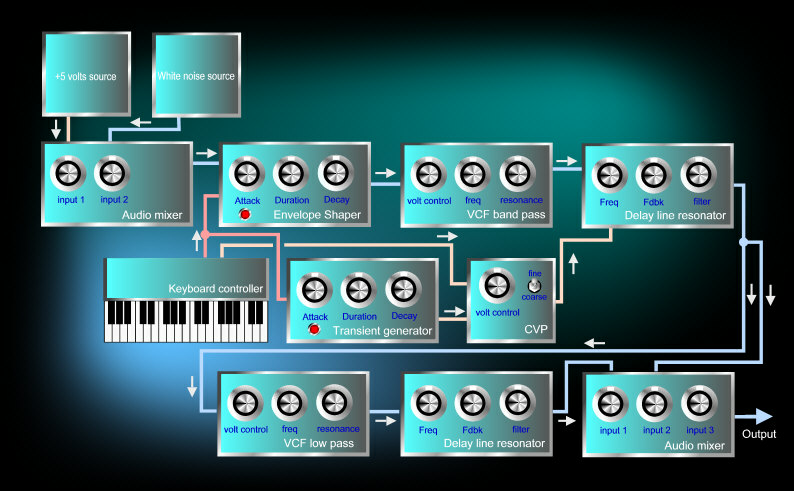
Acoustic Modelling 3.....

There is a softness and a give with most real strings due to the materials they are made from. By introducing the delay line’s inbuilt mild low pass filter or equaliser into the resonant loop, the high frequency gain is reduced and consequently higher harmonics will die away around the loop quicker than lower ones. The lower the frequency the filter is set, the ‘softer’ will be the material the string is made of.
There are also other simple possibilities to add to the basic model. String tension is increased a bit when a string is plucked, after which it quickly returns to normal as the sound dies away. Most plucked strings either have a body to further resonate the sound or say an electronic pickup to allow the string sound to be amplified.
For this the model is developed further in the next two patches...
There are also other simple possibilities to add to the basic model. String tension is increased a bit when a string is plucked, after which it quickly returns to normal as the sound dies away. Most plucked strings either have a body to further resonate the sound or say an electronic pickup to allow the string sound to be amplified.
For this the model is developed further in the next two patches...
String developement....
Fully developed string patch with added body resonator.
In the patch shown above, the noise is pulsed as before by the envelope shaper top left. This time however a band pass filter is added to soften the noise before it goes into the delay line. The filter has its own resonance control which can change the response from broad to sharp peak. It’s a standard feature of synthesiser filter circuits like this one. This can be used to not only reduce the harshness of the ‘pick’ but add a bit of character as well.
On the second line a control voltage processor is inserted in the keyboard’s pitch control line. It is in turn controlled by an transient or envelope generator. As the CVP’s control input is advanced it brings in the the transient generator effect which is set to raise the pitch just at the start of the plucked sound, simulating a momentary stretch of the string.
To make it more interesting, a very crude ‘body' model is also added. A second delay line with its controls set to give a heavily filtered, inverted bass-end feedback is attached to the string model described so far. This added resonator is carefully adjusted to model a 'short stopped pipe' or 'hollow box'. (inverted feedback around delay lines works out that it resonates odd harmonics while non-inverted feedback resonates all harmonics). Coupling between 'string' and 'body' is via a low pass filter to affect different bridge and box materials'. The sound from the ‘box’ is added to the string sound using the mixer module, bottom right. Well I did say it was crude but there are already 24 knobs to play with! Although the coupling between box and string is strictly one way, it does work up to a point. The ‘body’ effect appears right at the end of the sound demo (sound example 1)
On the second line a control voltage processor is inserted in the keyboard’s pitch control line. It is in turn controlled by an transient or envelope generator. As the CVP’s control input is advanced it brings in the the transient generator effect which is set to raise the pitch just at the start of the plucked sound, simulating a momentary stretch of the string.
To make it more interesting, a very crude ‘body' model is also added. A second delay line with its controls set to give a heavily filtered, inverted bass-
All the sound clips that follow in this section are the original sound examples I used in my presentation to the International Computer Music Conference in 1988.
In the string sound clip example that follows with the next more fully developed string patch, after the ringing is established, you can hear the delay module's filter being slowly closed making the sound softer more like a nylon string. Next the tension is given a blip at the start of the note by the extra circuitry that modifies (blips) the keyboard voltage control source. Slowly the sound goes from a harsh pulse which still provides the excitation unaltered throughout, towards a soft far more real acoustic sound.
[SOUND EXAMPLE 1: Plucked string and development... MP3 (128kbit/sec)] - continuous string sound development. Starts with short repeated noise impulse (the bare pluck).. delay line feedback gradually added, the 'string' rings more and more, then feedback loop low pass filter roll off frequency reduced, softening the 'string',then initial quick pitch slur added.. Finally, simple 'body' resonance added to end up with a hollow wooden bodied soft string instrument.
.
[SOUND EXAMPLE 1: Plucked string and development... MP3 (128kbit/sec)] -
.
[SOUND EXAMPLE 2: Koto... MP3 (128kbit/sec)] - 'Koto type instrument'. Setting of the controls is crucial and there are 24 not counting the keyboard. Just playing only with the controls can radically alter the soft plucked string sound into something quite different!
| Home | Previous page | Next page |
Using a modular analogue synthesiser
Simple body too....